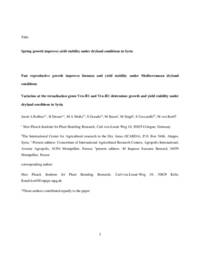Variation at the vernalisation genes Vrn‑H1 and Vrn‑H2 determines growth and yield stability in barley (Hordeum vulgare) grown under dryland conditions in Syria

Authors:
The objective of the present study was to identify
QTL influencing agronomic performance in rain-fed
Mediterranean environments in a recombinant inbred line
(RIL) population, ARKE derived from the Syrian barley
landrace, Arta and the Australian feed cultivar, Keel. The
population was field tested for agronomic performance at
two locations in Syria for 4 years with two sowing dates,
in autumn and winter. Genotypic variability in yield of
the RIL population was mainly affected by year-to-year
variation presumably caused by inter-annual differences in rainfall distribution. The spring growth habit and early
flowering inherited from the Australian cultivar Keel
increased plant height and biomass and improved yield stability
in Syrian environments. QTL for yield and biomass
coincided with the map location of flowering time genes,
in particular the vernalisation genes Vrn-H1 and Vrn-H2.
In marginal environments with terminal drought, the Vrn-
H1 allele inherited from Keel improved final biomass and
yield. Under changing climate conditions, such as shorter
winters, reduced rainfall, and early summer drought, spring
barley might thus outperform the traditional vernalisationsensitive
Syrian landraces. We present the ARKE population
as a valuable genetic resource to further elucidate the
genetics of drought adaptation of barley in the field.
